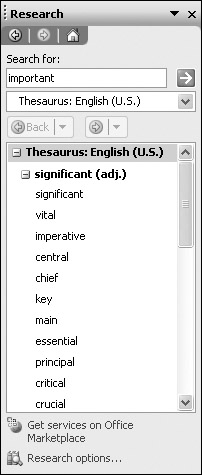Finding the Best Word
Language is often contextual ”the language you use in a letter to a friend is different from the language you use in business correspondence. To make sure you are using words that best convey your meaning in any given context, you can use Word s Thesaurus to look up alternative words or synonyms for a selected word. To use the Thesaurus, you select the word that you want to look up, and on the Tools menu, click Language and then Thesaurus. The Research task pane appears, displaying a list of synonyms with equivalent meanings.
In this exercise, you ll use the Thesaurus to replace one word with another.
USE the Thesaurus document in the practice file folder for this topic. This practice file is located in the ![]() My Documents\Microsoft Press\Office 2003 SBS\EditingProof\FindingWord folder and can also be accessed by clicking Start/All Programs/Microsoft Press/Microsoft Office System 2003 Step by Step .
My Documents\Microsoft Press\Office 2003 SBS\EditingProof\FindingWord folder and can also be accessed by clicking Start/All Programs/Microsoft Press/Microsoft Office System 2003 Step by Step .
OPEN the Thesaurus document.
-
Double-click the word important in the last line of the first paragraph.
-
On the Tools menu, click Language , and then click Thesaurus .
The Research task pane appears, listing synonyms for the word important .

-
Click the minus sign to the left of significant .
Word hides the list of synonyms under significant , bringing the synonym valuable and its own list of synonyms into view.
-
Click the plus sign to the left of significant , and then point to the word significant in the Meanings area just below it.
Word surrounds the meaning with a box containing a down arrow.
-
Click the down arrow to the right of the word significant (don t click the word itself), and click Insert on the drop-down menu.
Word replaces important with significant .
-
Close the Research task pane.
-
On the Standard toolbar, click the Save button.
Word saves your changes to the document.
CLOSE the Thesaurus document.
| |
Word provides a basic multi-language dictionary and translation feature so that you can look up text in the dictionary of a different language and translate words and phrases.
To translate text or look up words in another language:
-
If you want to translate a word or phrase, select it. If you want to look up a word or phrase, make sure nothing is selected.
-
On the Tools menu, point to Language , and then click Translate .
If you are prompted to install the feature, click Yes.
-
If you want to look up a word or phrase, type it in the Search for box, and click the adjacent Start searching button.
If you are translating a selection, the word or phrase already appears in the Search for box.
-
In the Translation area of the Research task pane, change the dictionary settings in the From and To boxes as necessary.
The translated text appears in the bottom part of the pane.
| |
| |
New in Office 2003 ”Research Service In addition to the Thesaurus, the Research task pane provides access to a varietyof informational resources, collectively known as the Research service , from within Word. You can enter a topic in the Search for text box and specify in the box below which resource Word should use to look for information regarding that topic. By clicking Research options at the bottom of the Research task pane, you can specify which of a predefined list of reference materials, such as Encarta and various Internet resources, will be available from a drop-down list, and you can add your own reference-material sources.
To use the Research service:
-
Display the Research task pane by clicking Research on the Tools menu.
-
In the Search for text box, type the topic you are interested in researching.
For example, you might type deer-proof plants .
-
Click the down arrow to the right of the text box below, and select the resource you want to use to search for information.
For example, you might click MSN Search.
-
Click the Start searching button.
The search results are displayed in the task pane.
-
Click the plus sign to the left of topics that interest you.
You can click a hyperlink to a Web address to go to the Web to track down further information. You can also select part of a topic, right-click to display a shortcut menu, click Copy, and then paste the selection into your document. Or you can click Look Up on the shortcut menu to research information about the selection.
| |
EAN: 2147483647
Pages: 350